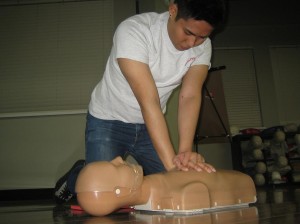Basic Life Support (BLS) is one of the most popular training classes offered by our training providers. The concept of BLS was created to serve as a set of periodically updated guidelines and techniques to follow when giving cardiopulmonary resuscitation. We have three available BLS programs for both the general public and healthcare providers (HCPs). All of these programs offer trainees certification once they comply with all the requirements upon finishing the program. Re-certification is also offered for certain classes.
Overview on BLS training
Because BLS training programs are typically short, they focus more on skill building, particularly on chest compressions and rescue breathing. Trainees are also introduced to the AED – automated external defibrillator – a machine that is attached to the chest with AED pads and sends electricity to the heart to normalize its rhythm. The Chain of Survival is also part of the BLS curriculum, teaching trainees “links” or steps to follow when managing cardiac arrest.
Cardiac arrest
Cardiac arrest is a term used to describe an emergency situation where the heart is not beating regularly or not beating at all. This prevents blood from circulating to the rest of the body, cutting off the supply of oxygen to our vital organs. This is very dangerous for the brain, wherein more than 7-10 minutes of poor oxygenation can cause brain damage or death. To get the blood pumping to the rest of the body during arrest, chest compressions and rescue breaths are given to the victim. Chest compressions should be 2 inches deep for adults and allow the chest to recoil before the next compression.

Available BLS programs
- Heartsaver CPR and AED – This basic CPR program is tailored for the public, teaching them how to perform one-person rescue on a victim. AED training and a few basic first aid skills are also included. 4 hours. No re-certification available.
- Heartsaver CPR and AED (C) – With the same program structure as Heartsaver CPR and AED, this program tailors all of the lessons for healthcare providers. 4.5 hours. No re-certification available.
- Basic Life Support for HCPs – This program is also tailored for healthcare providers but is more complex than Heartsaver CPR and AED (C). It teaches both one-person and two-person rescue and introduces trainees to the AHA’s BLS guidelines. Trainees are required to take a pre-test to qualify for this program. 4.5 hours. Re-certification is 4 hours.
Certificates
All three BLS programs are certificate courses. Students need to pass a skills test and/or a written exam to become certified rescuers. The general public program is only an optional certificate course; trainees can choose not to take the post-test (a skills test) to become certified rescuers. The two other programs for HCPs have post-tests that consist of a practical and written test at the end of lessons.
All credentials received from our training programs are valid for two years. If a rescuer wants to renew his or her training certificate, re-certification is available for BLS for HCPs. In the case of an expired certificate or if the program doesn’t have an available re-certification program, rescuers will have to retake the program.
